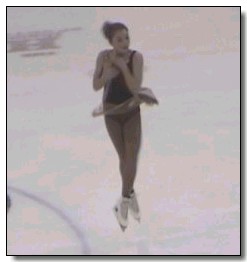Recognizing the Jumps
Jump Combinations and Sequences
Skaters often do 2 or more jumps "in a row", or grouped right after one another. When they do this, it is called a Jump Combination or a Jump Sequence. There is a difference between the two. A Jump Combination is performed when the 2nd jump takes off from the same edge that the previous jump landed on (in other words, there are no turns or changes of foot between jumps). If there are turns or foot changes between the jumps then the grouping of jumps is called a Jump Sequence.
When a skater performs a Jump Combination, the second jump will almost always be a Toe Loop or a Loop. This is because these jumps are the only ones that take off from a RBO edge (which nearly all jumps land on). Note however that there are some exceptions to this statement, always occurring when the first jump in the combo does not land on the "standard" RBO edge. The most common of these includes a Half Loop followed by a Salchow or a flip. A common Jump Sequence is Axel, mohawk, Axel.
Most combos include 2 jumps, but occasionally, 3-jump combinations are used (for instance, Axel-Half Loop-Double Salchow). There is no restriction on the number of jumps that may be performed in a Jump Sequence, but the Balanced Program Rules limit the number of jumps that may be performed in a Combination (as of August 2007, the rules permit ONE 3-jump combo in a FS program, any other combinations may include no more than 2 jumps).
Regardless of the number of jumps included WITHIN a combination or sequence, there IS a restriction on the NUMBER OF combinations and sequences that can be performed. Skaters should not perform more than 3 combos or sequences in an FS program at any level.
